Nixeus VUE 30: 30" 2560x1600 IPS Monitor Review
by Chris Heinonen on August 20, 2013 6:00 AM ESTTested using the Leo Bodnar lag tester, I measured 29.23ms of lag with a 1080p signal on the VUE 30. TO use the Leo Bodnar I average the three areas of the screen; top, middle, and bottom, that it can provide data for. With the VUE 30 the Top and Middle were both really low, at 21.6ms and 27.5ms, but it jumped up to 38.6ms at the bottom. I usually see variations of around 7-8ms between the areas, or roughly half the 16.7ms it takes to move between frames, but not a spread of 6ms and then 11ms.
Despite that weird measurement, I didn’t see any tearing or anything else that might be an issue when using the Nixeus for gaming. I’ll just chalk it up to some slightly strange behavior with the scaler and its timing, but not something that I could actually see a problem with. Note also that lag might be lower running at the native 2560x1600, but I can't directly compare that with most other displays as they lack support for that resolution.
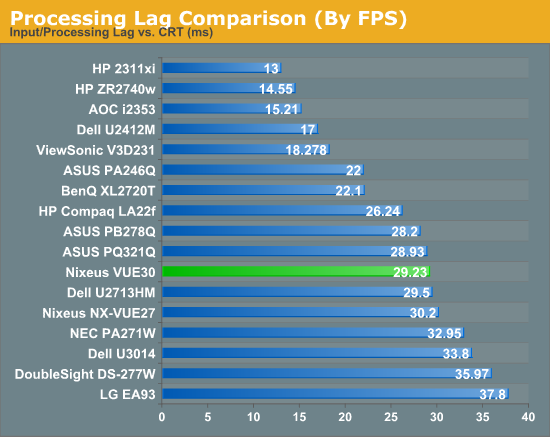
Power use is not a good area for the Nixeus. It is rated for < 130 watts of power consumption on the specs, but my unit managed to use over 150 watts at peak brightness. Since the peak brightness was also almost 75 cd/m2 below the specs, that is a large difference there in the power measurements. A white screen also uses less energy than a black screen with an LCD typically, so I’m not sure what would provide a power measurement that low while running at maximum brightness. Most likely Nixeus is rating power use by how much the display requires and not accounting for the efficiency of the power brick; 85% efficiency at 130W would give us 153W, which is close to what I'm seeing, but it's still quite a bit higher than a modern LED backlit display.
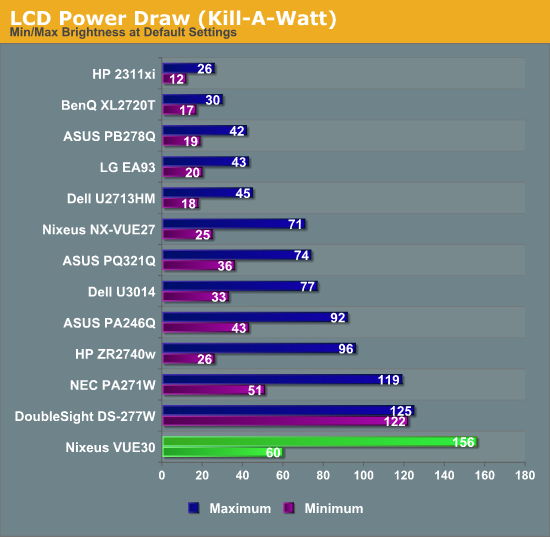
Going down to minimum brightness drops the power use to 60 watts, which is much more reasonable. Using my formula to get candelas per square inch per watt, the Nixeus came in dead last among the displays I have tested. All of the 30” displays do poorly here, as their more complex backlighting systems use a lot more power, but the Nixeus is the worst offender.
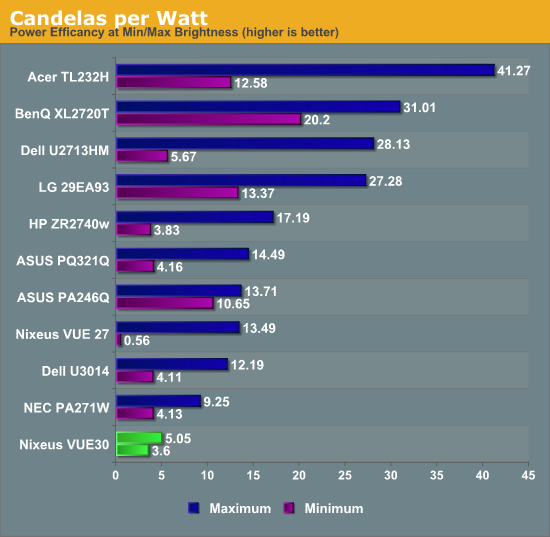
Running the Nixeus profile through Gamutvision, we see 103% coverage of the AdobeRGB gamut. This falls short of some other displays, but still is full coverage and as we saw it works pretty well when in AdobeRGB mode.
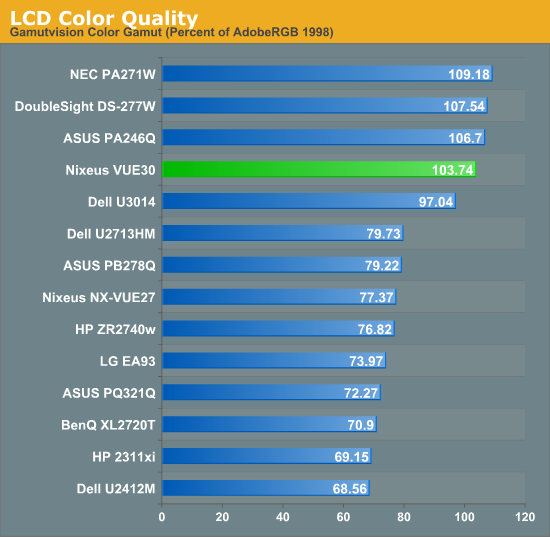
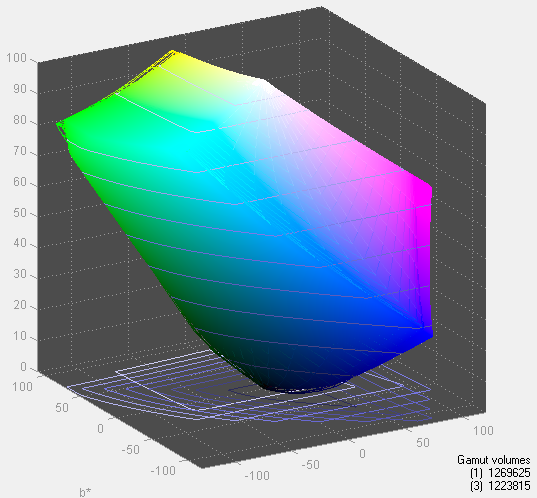


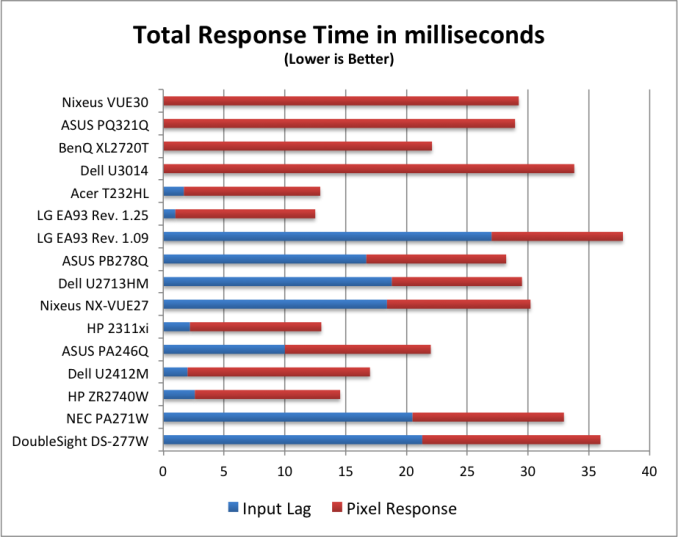








95 Comments
View All Comments
Sabresiberian - Tuesday, August 20, 2013 - link
It is great to see prices drop this much, but the standard 30" screen still has a serious problem, in my eyes. .25mm dot pitch.Okay that isn't terrible; it's something I could live with. But the fact is, I can buy a 27" with much better dot pitch (.233mm) and spend a lot less money. I hate the 16:9, but it isn't as bad as .25mm for me in that large of a display, personally, so the trade-off means I'll go with spending less money to get something a bit closer to what I want.
Give me 16:10.
Give me at least (most?) .233mm dot pitch, - better certainly isn't an unreasonable thing to ask in this day and age.
Give me an IPS panel (or comparable, or, gasp even better!), preferably with a backlight solution that doesn't feel like a heat lamp shining on my face.
Give me accurate colors, a uniform display, screen surface that isn't too reflective OR to heavily anti-reflective, a thin bezel so I can put 3 of them side-by-side without big spaces between the displays..
Give me low lag.
Sell it to me for less than $600. Really, I think $500 isn't unreasonable, but I'll buy it at $600.
JarredWalton - Tuesday, August 20, 2013 - link
Windows still doesn't handle odd DPI all that well, though 8.1 may improve this. As someone who has used 30" LCDs for years now, I will tell you that I have no issues with the dot pitch, and in fact I often have to increase the magnification to read text comfortably. I think a dot pitch for desktop displays of around 0.28-0.30mm is actually better for most people past 30 years old. For businesses with 40+ year old employees, I have had many instances where I had to set their 1080p or 1920x1200 display to run at a lower resolution because the user complained that the text was too small.So, sorry to burst your bubble, but in the larger market of the world (e.g. people older than 25) having higher DPI is not actually all that important or even desirable. Not to mention, if you had a 4K 25" display, you need GPUs capable of driving that resolution at a reasonable level of performance. Just like the business world doesn't worry too much about high DPI displays, they're not interested in high performance GPUs for general computer use either.
josephandrews222 - Tuesday, August 20, 2013 - link
GREAT comment about dot pitch and age. I'd like to see an anandtech article about dot pitch that addresses this very topic...in detail.Impulses - Tuesday, August 20, 2013 - link
These displays aren't marketed at the business world either tho...stephenbrooks - Friday, August 23, 2013 - link
Right on with the dot pitch comment. I recently got to work on a 27" 1440p display and felt I had to set the Windows 7 UI & font scaling to 125% rather than 100% (I'm 29). The side-effect was that 125% looked kind of "Mac like" with high res fonts still the same size, whereas 100% was like trying to work at a scale designed for ultraportable laptops.seapeople - Saturday, August 24, 2013 - link
I call BS. My eyesight is TERRIBLE. I can't see the broadside of a barn if it was flying at me and mooing. But I have these wonderful things called glasses. It's not like glasses stop working when you get older. I currently am sitting about 24 inches from my 125 ppi laptop screen and I can still tell that the text is not nearly as clear as it could be (i.e., on the retina iPad). For example, > ... that's not a smooth, clean arrow, it's a blocky/fuzzy travesty that would look so much better with more pixels in it.menting - Tuesday, August 20, 2013 - link
Does this monitor use PWM for brightness?I wish more monitor reviews would cover this section as well, as I (and quite a few others) find PWM annoying and tiring to the eyes
mdrejhon - Wednesday, August 21, 2013 - link
You can test a monitor's PWM by using http://www.testufo.com/#test=blurtrailmdrejhon - Wednesday, August 21, 2013 - link
Oh, and when testing TestUFO, make sure to use the Chrome browser, and lower brightness to 0% to check for the PWM artifact.ezridah - Tuesday, August 20, 2013 - link
You should review the 4 different Monoprice monitors. They have 2 types at each size and the low end ones are significantly cheaper than this.